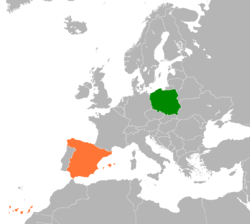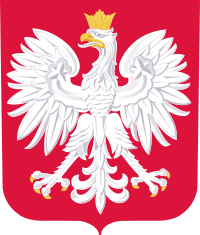Poland–Spain relations
Poland–Spain relations are cultural and political relations between Poland and Spain. Both nations are members of the European Union, Organisation for Economic Co-operation and Development, NATO and the United Nations.
 | |
Poland |
Spain |
|---|---|
Historical relations
First contact between the Kingdoms of Poland and Spain date to Late Middle Ages, where merchants, travelers and Jesuits traveled between both countries. Early Polish diplomats in Spain in the 16th century included Johannes Dantiscus and Piotr Dunin-Wolski.[1][2] While the Polish and Spanish forms of governments evolved in a different direction, the diplomacy of both countries was more likely to support one another than not.[3][4] Spain was the only country to protest over the First Partition of Poland, and in 1795, following the final Third Partition of Poland, Spanish diplomat Don Domingo de Yriarte was one of the last foreign diplomats to vacate his post in Warsaw.[4]
During the Peninsular War (1809–1814) in Spain, a number of Polish soldiers fought on the side of Napoleon. The Vistula Legion gained fame at the Battle of Saragossa.[5] The Polish Chevau-léger regiment distinguished itself at the Battle of Somosierra in 1808[4] In the early 20th century a number of Polish volunteers participated in the Spanish Civil War on the Republican side and were primarily assigned to the Dabrowski Battalion.[6][7]
Poland and Spain re-established diplomatic relations on 30 May 1919, in the aftermath of World War I.[8] During World War II, Spain remained neutral and did not participate in the war directly. In 1945, Poland regained its independence after Nazi and Soviet occupation. Relations between Poland and Spain were not re-established until 31 January 1977, as the government of the People's Republic of Poland refused to recognize the Falangist government of General Francisco Franco.[8] After the Autumn of Nations and formation of a new, non-communist Polish government, both countries signed a Treaty of Friendship and Cooperation in 1992.[8] In 1998, both countries signed a Common Polish-Spanish Declaration.[8] Since 2003, irregular bilateral conferences between prime ministers of both nations take place; as of 2012 eight such meetings have taken place.[8][9]
High-level visits

Presidential and Prime Ministerial visits from Poland to Spain[10]
- Prime Minister Tadeusz Mazowiecki (1990)
- President Aleksander Kwaśniewski (2003)
- Prime Minister Kazimierz Marcinkiewicz (2006)
- President Lech Kaczyński (2008)
- Prime Minister Donald Tusk (2011 and 2013)
- President Bronisław Komorowski (2011)
- Prime Minister Ewa Kopacz (2015)
Royal and Prime Ministerial visits from Spain to Poland
- King Juan Carlos I of Spain (1989 and 2001)
- Prime Minister José María Aznar (2004 and 2007)
- Prime Minister José Luis Rodríguez Zapatero (2009)
- Crown Prince Felipe (2012)
- Prime Minister Mariano Rajoy (2012, 2014, 2016)
- Prime Minister Pedro Sánchez (2018)
Cultural relations
Certain ties in Polish and Spanish cultures can be explained by the fact that Poland and Spain had the highest percentage of petty nobility in Europe (hidalgos, szlachta), which encouraged ties between educated elites, and mutual references.[3][11] Even more importantly, both countries also shared a strong Catholic history, on the frontier of struggles against the Muslims (Antemurale Christianitatis, Reconquista).[3] Spain had a significant influence on Polish culture, particularly in literature.[3][4] Spanish works have been translated into Polish and Spain was a setting of some famous Polish works such as The Manuscript Found in Saragossa, and influenced major Polish literary figures, such as Juliusz Słowacki.[12]
In the 21st century both governments promoted their partner's culture at home, with the Polish Year in Spain in 2002 and the Spanish Year in Poland in 2003.[13] Spain is a popular tourist destination for Poles, with about half a million of Poles visiting Spain each year. Spanish language is a popular foreign language to learn in Poland.
Polish community in Spain
Spain has an estimated Polish community of 100,000 people, many who arrived to Spain after World War II and after Poland joined the European Union in 2004.[8]
Trade
In 2017, trade between Poland Spain totaled €8 billion Euros.[10] Poland's main exports to Spain include: automobile, machinery, pharmaceutical products, electronics and furniture. Spain's main exports to Poland include: automobiles, electrical equipment, electronics and machinery.[14] In 2016, Spanish companies invested €171 million Euros in Poland, becoming the 6th largest foreign direct investor in the country.[10]
Resident diplomatic missions

- Poland has an embassy in Madrid and a consulate-general in Barcelona.[15]
- Spain has an embassy in Warsaw.[16]
Notes
- Harold B. Segel (1989). Renaissance Culture in Poland: The Rise of Humanism, 1470-1543. Cornell University Press. pp. 175–176. ISBN 978-0-8014-2286-7. Retrieved 24 October 2012.
- Adam Kucharski (1 January 2007). Hiszpania i Hiszpanie w relacjach Polaków: wrażenia z podróży i pobytu od XVI do początków XIX w. Wydawnictwo Naukowe Semper. p. 117. ISBN 978-83-7507-022-4. Retrieved 24 October 2012.
- Marek Jan Chodakiewicz; John Radzilowski (2003). Spanish Carlism and Polish Nationalism: The Borderlands of Europe in the 19th and 20th Centuries. Transaction Publishers. p. 46. ISBN 978-0-9679960-5-9. Retrieved 24 October 2012.
- Marek Jan Chodakiewicz; John Radzilowski (2003). Spanish Carlism and Polish Nationalism: The Borderlands of Europe in the 19th and 20th Centuries. Transaction Publishers. p. 47. ISBN 978-0-9679960-5-9. Retrieved 24 October 2012.
- George Nafziger and Tad J. Kwiatkowski, The Polish Vistula Legion. Napoleon. No. 1 : January 1996
- "Dąbrowszczacy". IPN. Retrieved 24 October 2012.
- "A Telling "Omission"". Osaarchivum.org. Archived from the original on 2017-09-22. Retrieved 2012-10-24.
- "Bilateral cooperation". Msz.gov.pl. Retrieved 2019-03-07.
- "Kontakty polityczne" (in Polish). Madryt.msz.gov.pl. Retrieved 2012-10-24.
- Ficha de País: Polonia (in Spanish)
- Norman Davies (1996). Europe: A History. Oxford University Press. p. 584. ISBN 978-0-19-820171-7. Retrieved 24 October 2012.
- Marek Jan Chodakiewicz; John Radzilowski (2003). Spanish Carlism and Polish Nationalism: The Borderlands of Europe in the 19th and 20th Centuries. Transaction Publishers. p. 48. ISBN 978-0-9679960-5-9. Retrieved 24 October 2012.
- "Kultura i nauka" (in Polish). Msz.gov.pl. Retrieved 2012-10-24.
- Polonia, Situación de las Relaciones Comerciales con España (in Spanish)
- Embassy of Poland in Madrid
- Embassy of Spain in Warsaw
Further reading
- Gabriela Makowiecka, Po drogach polsko-hiszpańskich, Wydawnictwo Literackie, Kraków, 1984
External links
- Bak, Grzegorz, La imagen de España en la literatura polaca del siglo XIX [Recurso electrónico] : (diarios, memorias, libros de viajes y otros testimonios literarios) / Grzegorz Bak ; director, Fernando Presa González, Madrid: Universidad Complutense de Madrid, Servicio de Publicaciones, 2004
- BIBLIOGRAFÍA DE INTERÉS HISPANO-POLACO. En la biblioteca Guillermo Cabrera Infante (Instituto Cervantes de Varsovia)
- Beata Wojna, Stosunki polsko-hiszpańskie w Unii Europejskiej, Biuletyn PISM, nr 18 (263), 2005-03-03
- Polonia.es - page of the Polish minority in Spain
- Bilateral cooperation, Polish Embassy in Madrit, Spain

.svg.png)